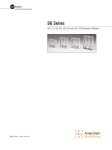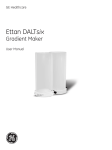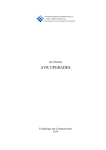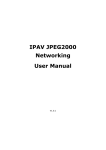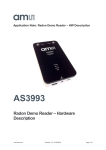Download Hoefer SG500
Transcript
user manual Hoefer SG500 Gradient maker um SG500-IM/Rev.E0/08-12 Page finder SG500 instructions................................................1 1. Generating linear gradients..................................2 Pouring gradients from the top ...........................4 Pouring gradients from the bottom.......................5 2. G enerating convex and concave exponential gradients...........................................................6 To generate an exponential gradient.....................7 3. Care and maintenance........................................9 4. Ordering information...........................................9 • pi SG500 instructions The Hoefer® SG500 gradient maker is designed for producing linear gradients of aqueous solutions ranging in volume from 100–500 ml. The SG500 can be used to create convex and concave exponential gradients with the addition of a one-holed rubber stopper, a piece of rigid tubing and a piece of flexible tubing. The unit is fabricated from cast acrylic plastic sheet and tubing. It is suitable for casting acrylamide pore gradient gels and delivering salt gradients for low pressure chromatography systems. reservoir (back) chamber mixing (front) chamber Fig 1. Hoefer SG500 gradient maker. Included but not shown: Hose clamps (4) outlet connector (4 mm ID tubing) slide stop push-pull valve connector channel • p1 1. Generating linear gradients To generate a linear gradient between two concentrations, equal volumes of solutions of the two concentrations are measured into the two chambers of the gradient maker. As solution is delivered out of the mixing chamber, an equal volume flows in from the reservoir chamber where it is rapidly diluted and mixed to uniformity by a magnetic stir bar. The initial concentration delivered will be that of the solution in the mixing chamber, the final concentration will be that of the reservoir chamber. For the most consistent delivery of gradients, a peristaltic pump is recommended. 1 ake sure all parts are clean and liquid flows freely M through all the connecting channel of the slide valve and pump and delivery tubing. 2 open closed Fig 2. Open and closed positions of slide valve. • p2 Add a magnetic stir bar of the appropriate dimensions (20–30 mm long) to the mixing chamber and place the unit on a magnetic stirrer. If volumes will be less than half the capacity of the unit, an identical stir bar should be placed in the reservoir chamber as well to balance the displacement and prevent backflow into the reservoir when the chambers are first connected. Connect tubing to the outlet connector and pump, and adjust pump speed, if used. Position or connect the tubing to the receiving vessel (gel casting unit, column, etc.). 3 lose the slide valve (out on side of white slide stop C button, Fig 2). If the outlet tubing is not controlled by a pump, clamp it off near the gradient former. Add the required volume of the final solution to the reservoir (back) chamber. 4 Note: If there is a substantial difference in densities between the two solutions, there will be a sudden flow from the denser chamber to the lighter chamber to bring the two into hydrostatic balance. This will result in the gradient not being fully linear. To avoid this, add equal weights, rather than volumes, of the solutions to the appropriate chambers. Carefully open the slide valve and allow just enough solution to flow through the connector channel to fill it to the edge of the mixing chamber, then close the valve. Be sure no large bubbles remain to obstruct flow through the channel. 5 dd the required volume of the starting solution to A the mixing chamber and start the magnetic stirrer. 6 Open the outlet tubing if clamped off. 7 Simultaneously start the pump. 8 If it is important that no bubbles disturb the gradient, watch the delivery carefully and as soon as the last of the solution has entered the pump head, stop the pump and clamp off the tubing to the receiving container. 9 Flush and rinse all parts thoroughly with distilled water after use. • p3 Pouring gradients from the top Filling a container with a gradient (e.g. casting acrylamide pore gradient gels) can be done either dense solution first (“from the top”), or light solution first (“from the bottom”). To fill from the top: 1 Proceed as described in Section 1, putting light (final or top) solution in the reservoir chamber (step 3) and dense solution in the mixing chamber (step 5). 2 lace the delivery outlet against the upper edge of P the receiving container. Adjust the pump rate so that the solution flows evenly down the side in a smooth, continuous stream. The delivery speed should be slow enough that the newly arriving solution does not mix with the underlying solution. Alternatively, using a rigid cannula at the end of the delivery tubing, hold the tip of the cannula just above the surface of the solution, raising it smoothly as the container fills. • p4 Pouring gradients from the bottom This technique is commonly used in filling multiple gel casting chambers. 1 Proceed as described in Section 1, putting dense (final or bottom) solution in the reservoir chamber (step 3) and light solution in the mixing chamber (step 5). 2 In step 2, connect the outlet tubing to the bottom inlet of a gel casting unit or to a cannula long enough to reach the bottom of the receiving container. Adjust the pump rate so that the solution is not forced up in a “fountain” that mixes with the overlying solution. 3 If all of the gradient solution must be delivered to the container, a displacement solution may be used. Just as the last of the gradient mix is pumped out of the mixing chamber, and before any air enters the tubing, add an appropriate volume of a denser displacement solution to the mixing chamber and pump it through until all of the gradient mix has been delivered. It is convenient to include a dye in the displacement solution to visually track the boundary between the gradient mix and the displacement solution. • p5 2. Generating convex and concave exponential gradients Eq 1. By holding the volume in the mixing chamber constant (as opposed to declining for linear gradients), the gradient generated will have an exponential concentration curve. The mixing volume in the SG500 unit can be held constant by sealing the top of the mixing chamber with a rubber stopper and tubing assembly (Fig 4). The total volume of the gradient can be greater than the maximum volume of the gradient former because additional solution can be repeatedly added to the reservoir chamber. Using Eq 1, examples of the gradients generated by various combinations of volumes and concentrations listed in Table 1 are plotted in Fig 3. Concave gradients are generated high concentration first, and thus containers such as gel cassettes must be filled from the top. Convex gradients must be filled from the bottom. Most frequently used is the concave pore gradient for increased resolution in the high molecular weight region of acrylamide gels. Table 1. Examples of concave and convex exponential gradients A B C D E Cres* 0 1 1 1 0.5 Vres 500 500 100 500 500 Cmix 1 0 0 0.5 1 Vmix 100 100 500 100 100 *Volumes are relative. C: concentration, V: volume, res: reservoir chamber, mix: mixing chamber • p6 1.0 0.9 relative concentration Fig 3. Examples of exponential gradients. D 0.8 B 0.7 0.6 E 0.5 0.4 0.3 A 0.2 C 0.1 0.0 0% 20% 40% 60% 80% 100% % of gradient delivered To generate an exponential gradient: 1 ake sure all parts are clean and liquid flows freely M through all channels, stopcocks and tubing. 2 Assemble the stopper. Select a one-hole rubber stopper that fits securely in the top of the mixing chamber. Attach a short piece of flexible vinyl tubing that can be clamped off to make an airtight seal to a rigid piece of glass or plastic tubing that fits tightly in the hole of the stopper. The stopper assembly should seal the mixing chamber airtight when the slide valve is closed and the outlet tubing is clamped off. 3 Add a magnetic stir bar of the appropriate dimensions (20–30 mm long) to the mixing chamber and place the unit on a magnetic stirrer. Connect tubing to the outlet connector and pump, then adjust pump speed, if needed. Position or connect the tubing to the receiving vessel (gel casting unit, centrifuge tube, etc.) at top or bottom, as appropriate. • p7 4 Close the slide valve and add a portion of the final solution to the reservoir (back) chamber. 5 Carefully open the slide valve and allow just enough solution to flow through the connector channel to fill it to the edge of the mixing chamber, then close the valve. Be sure no large bubbles remain to obstruct flow through the channel. 6 Fig 4. Gradient maker with plunger in place. Add the required volume of the starting solution to the mixing chamber. With the stopper tubing open, insert the stopper assembly securely into the mixing chamber (Fig 4). Clamp off the tubing on the vent airtight. 7 Note: If the gradient volume is larger than the reservoir will hold, the additional volume can be added during the gradient delivery. Do not allow the reservoir chamber to go dry as bubbles will be pulled into the mixing chamber, changing the dilution volume and gradient shape. Note: The entire solution remaining in the mixing chamber is at the final concentration and does not contribute further to the gradient. If desired, it can be used as a displacement solution for convex gradients unless it contains acrylamide. • p8 tart the magnetic stirrer and unclamp the outlet S tubing if needed. 8 Simultaneously open the slide valve and start the pump. 9 Stop the pump and remove the tubing from the receiving container as soon as the last of the solution has left the reservoir chamber. Disconnect tubing. Flush and rinse all parts thoroughly with distilled water after use. 3. Care and maintenance The gradient maker should be cleaned thoroughly with distilled water after use to prevent polymerization or crystallization of solutions in the chambers and stopcocks. Do not use abrasives, acetone, pure alcohols or organic solvents to clean this unit. 4. Ordering information product qty. code no. SG500 Gradient Maker, 500 ml total volume 1 SG500 Push-pull valve for salt gradient 1 SG500-10 Red outlet fitting, 4 mm 4 XPO10 Push-pull valve replacement 1 SG500-1 • p9 Hoefer, Inc. 84 October Hill Road Holliston, MA 01746 Toll Free: 1-800-227-4750 Phone: 1-508-893-8999 Fax: 1-508-893-0176 E-mail: [email protected] Web: www.hoeferinc.com Hoefer is a registered trademark of Hoefer, Inc. © 2012 Hoefer, Inc. — All rights reserved. Printed in the USA.












